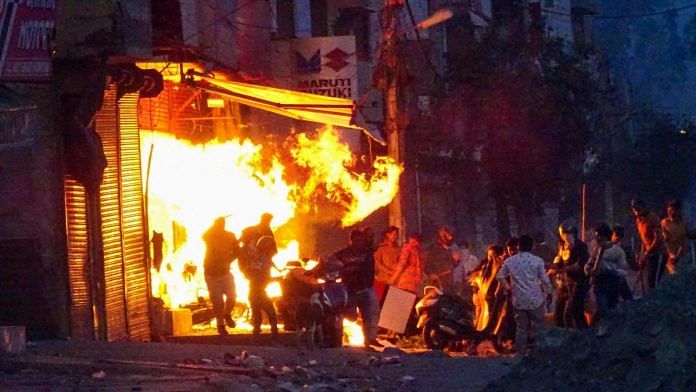
New Delhi: In the first conviction in the northeast Delhi riots case, a court Monday convicted a man in a case related to the robbery, vandalising and burning of a woman’s house on 25 February last year.
From the testimony of the police witnesses in the case, Judge Virender Bhat concluded, “Therefore, it is established that there was an unlawful assembly, the common object of which was to assault the persons belonging to Muslim community, damage their vehicles, loot and set ablaze the houses.”
The judge then convicted Dinesh Yadav alias Michael, observing, “The circumstances in which the members of Muslim community were identified & beaten, their vehicles damaged and their houses broken open, robbed and set ablaze by the rioters comprising the members of the other community, coupled with the object of the unlawful assembly i.e. to assault the Muslims & damage their properties, and the fact that the accused was seen amongst the rioters armed with a wooden rod, are sufficient to indicate beyond any doubt that he too shared the common object of the assembly and had knowledge that these types of incidents would be indulged into by the members of the assembly.”
Yadav had been charged with various provisions of the Indian Penal Code (IPC), including Sections 143 (punishment for being a member of an unlawful assembly), 147 (rioting), 148 (rioting, armed with deadly weapon), 457 (lurking house-trespass or house breaking), 392 (robbery), and 436 (mischief by fire or explosive substance with intent to destroy house etc).
The prosecution had alleged that on 25 February 2020, a mob of around 150 to 200 rioters gathered outside the complainant, Manori’s, home at around 11.30 am. They then allegedly barged into the house after breaking its gate, stole important documents such as sale deeds, gold and silver ornaments, cash, utensils, clothes, and a kettle. It was also alleged that this mob burned some of the goods, while damaging others.
According to the order, the prosecution claimed that the complainant jumped over to the roof of the adjoining house along with her children, to save their lives.
An FIR in the case was then registered on 3 March 2020.
Also read: Nothing in speech caused religious animosity, Sharjeel Imam tells Delhi court
Witnesses turned hostile
In the order, the court noted that Manori had not seen or identified any of the people who vandalised her house, claiming that she was not present at the time of the incident.
She was declared a hostile witness during the trial, as she denied having told the police that she had been present.
Two other witnesses in the case, whose house was also set ablaze, deposed that they could not identify any of the rioters. During cross examination, these witnesses were also declared hostile after they denied being present when the incident occurred.
Despite these denials, the court found that the mob had in fact vandalised and robbed the witnesses’ houses.
It observed that even though the “victims” hadn’t identified any of the rioters, “their testimonies establish the fact that their houses had been trespassed into after breaking open the locks, vandalised, robbed and then set on fire by a violent mob. Therefore, the offences u/s 143/147/148/457/392/436 IPC read with Section 149 IPC were committed by the persons comprising the mob.”
Police witnesses identified accused
The court went on to refer to the testimonies of constable Vipin and head constable Sanoj, who were present in the area on 25 February to curb the riots. It said that “their deposition clearly establishes the fact that the accused Dinesh Yadav @ Michael was part of the mob which had attacked, looted and set ablaze the house of the complainant”.
Vipin told the court that on the day of the incident, he saw rioters identifying Muslim people, segregating them and beating them up. He also submitted that vehicles belonging to Muslims were being burned and houses were being set on fire.
The order noted that while Vipin identified Yadav from among the rioters, he didn’t see Yadav entering the house, setting it on fire, or vandalising it.
The court noted that Sanoj had deposed on similar lines.
Yadav’s lawyer, on the other hand, contended that the witnesses had not attributed any active role to him and that he was only a bystander who lived in the vicinity.
The court, however, ruled that merely because Yadav wasn’t seen entering Manori’s house or vandalising it, it does not mean that he was a bystander.
It then observed that “the rioters comprising the unlawful assembly belonged to Hindu community whereas the victims who were beaten & whose houses/ shops were vandalised, looted and burnt belonged to the members of Muslim community.”
“The fact that the accused also belongs to Hindu community and was present in the mob armed with a wooden rod while the mob resorted to violence against the Muslims, indicates that he shared the common object of the unlawful assembly,” it added.
(Edited by Rohan Manoj)
Also read: ‘We waited for wages, he came with sword & chopped hand off’ — horror story of Dalit man in MP

COMMENTS